Muriel Fortescue (Mabel Normand)
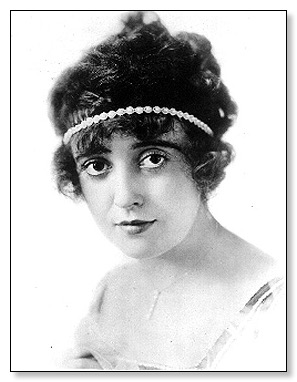
Mabel Normand:
The Beautiful Knockabout
A Silents Majority Featured Star
Born November 9, 1892, on Staten Island, NY
Died February 23, 1930, in Monrovia, CA
Mabel Normand was a contemporary of Mary Pickford, the Gish sisters (Lillian and Dorothy), Blanche Sweet, Florence Lawrence and the Talmadge sisters (Norma and Constance). She made her film debut in either The Indiscretions of Betty (Vitagraph, 1910) or Over the Garden Wall (Vitagraph, 1910) as a serious, dramatic actress (it is unclear which film was first). Before that, Mabel was already popular as a model for fashions and illustrations. Throughout parts of 1910 and 1911, Mabel worked for the Vitagraph studio. By the end of 1911, she had moved on to American Biograph under the direction of D.W. Griffith. She worked very hard to hone her craft by cranking out a number of melodramas, one of which, The Mender of Nets (1912), starred Mary Pickford. Fortunately, Mabel was proud of the Normand name and was determined to keep it. If she hadn't been, she may have become known to her fans as "Muriel Fortesque," the generic marquee name assigned to her to enforce the anonymity that was required of early screen performers. Mabel Normand never could and never would remain anonymous.
Mabel was strikingly beautiful, but that wasn't unusual for actresses. During this early period in their careers, Mary, Lillian, Dorothy and the rest were considered heartbreakingly beautiful. What made Mabel different is that, when she fell down, she was as funny as she was fetching. It didn't take long for Griffith to realize that Mabel had great comic talent, and he started assigning her to comical plots. Griffith, a drama director, employed a young actor-turned-director named Mack Sennett to guide Mabel's comic hijinks. [Sennett's movie-making career, like those of many of the Greats, began with Griffith. His intense desire to learn at the feet of the master and fully realize his ambitions, catapulted him up the ladder to the director's chair at Biograph.]
Mabel took her first shot at comedy in The Diving Girl (Biograph, 1911), in a charming and memorable role as a funny (and not a little sexy) bathing beauty. As men remember the first time they saw Marilyn Monroe in a bathing suit, the men and boys of the early 1910s never forget the first time the adorable Mabel donned a bathing costume. So, historically, the first Sennett bathing beauty was our Beautiful Knockabout, Mabel. (Master director King Vidor saw Mabel in that clinging suit when he was a young pup in Galveston, Texas - and claims that her image stayed with him and initially spurred his dream to make movies.)
What? A beautiful slapstick comedienne? Audiences were used to seeing screen comediennes who looked as funny as their antics. These included such funny girls as Flora Finch, who was built like a bean pole; Louise Fazenda, a kooky clown with the fashion sense of a country bumpkin; Polly Moran, a wild-haired, man-chasing harridan; and Marie Dressler, hefty and hilarious, but who declared, "I born without a pretty face, and thank the Lord I do not have to live up to such a burden." Beautiful Mabel could take a hearty pratfall with the best of the Keystone Kops, but one could also fall in love with her as a custard pie was thrust into that angelic face. Like a gambler with a sure bet, Mack could see that his future with Mabel was in the cards.
As vivacious and charismatic as Mabel was, one can't think of her without thinking of Mack. As soon as he spotted her captivating beauty adorned with her comic gifts (and it didn't take long), he turned on the old Sennett charm and skillfully won her over - plucking her heartstrings in the process. By September 1912, most of her films were being directed by Sennett, still at the eastern Biograph studio. Between February and September, that same year, the two cranked out no less than 22 one- and two-reelers. Then, in late September, Mack took his comic protégée (and by now the love of his life) out West and formed his own studio in Hollywood - Keystone.
Our knockout-knockabout made dozens of bright and lively farces in the Sennett style at Keystone between 1912 and 1916 with early Keystone stalwarts like Fred Mace, Hank Mann, Ford Sterling, Al St. John, Harry Gribbon, Mack Swain, Roscoe Arbuckle, Charlie Chaplin, Minta Durfee (one of her closest friends) and Luke the dog. However, Mabel wanted more. Beginning in early 1914, Mabel took over completely as her own director, beginning with the one-reeler Mabel's Stormy Love Affair (Keystone/Mutual, 1914). Mabel could claim the rare and unique distinction of directing the great Charlie Chaplin early in his Keystone Kontract. Charlie liked Mabel. He even had a crush on her at one point (who didn't?), but being directed by a woman, or anyone for that matter, put his little mustache out of kilter. He could barely tolerate being directed by her in two films, Caught in a Cabaret (1914) and Mabel's Busy Day (1914).
As Mabel's fame and fortune grew, so did her intense relationship with Mack. Those two "Wild Irish Roses" alternately courted and clobbered each other in their dizzy affair. Mack was forever trying to tame his "I-don't-care" girl, as she came to be known. Mabel was trying to elevate Mack to a classier stature. However, the strapping Irishman was set in his ways. A good gag and a good cigar was the creed he lived by. They were together so long that marriage seemed inevitable - but it never happened. Mack ultimately betrayed Mabel by his dalliance with another beautiful actress just before the wedding was to take place. There was a change in Mabel after that. She began her attempt to walk out of Mack's life He would not let her go easily and dangled an enticing carrot that included her own studio and production company, plus a film that he knew she could not resist.
At that point, Mabel desperately wanted to get out of knockabout and into "classier productions." She fell in love with the concept of Mickey because it was the desired departure from her slapstick past. Mack showcased Mabel as he promised. In an ad for the film it states, "No rough comedy, no flying pies, no innocent heroine seduced, no buckets of blood and no padding." However, among other stunts, Mabel as "Mickey" does slide down banisters, has a squirrel run up her pants leg, pound her fist on a layer cake (no tossing, though!) and, oh yes, jockey a race horse. But none of the disclaimers made in the ad. Nevertheless, the tension between Mack and Mabel came to a head before filming was over. During the production she signed a contract with Samuel Goldwyn, sealing her departure from Mack and Keystone - no matter what. By 1917, Mabel had slipped through Mack's fingers, privately and professionally.
Life had escalated into one long, endless pain-killing party for Mabel. She suppressed her enormous disillusionment mostly through alcohol. Adela Rogers St. Johns, famous Hearst columnist and longtime, great friend of Mabel's said simply, "I adored Mabel. She was my best friend - but Irish women can't drink" - and Mabel couldn't. After she left Mack, an innocence left her. Her pictures finally became classier, full-length features, but her freshness and drive dwindled. Even by the time Mabel realized her downward spiral and tried to stop it, the scandals descended. She began to decline alarmingly, bit by miserable bit.
Mabel was a dear friend and successful comedy partner (between 1913 and 1916) of Roscoe "Fatty" Arbuckle. Arbuckle, tainted by allegations of assault and murder, and subsequent trials in 1921, negatively affected many in the Hollywood community, including Mabel. A woman of integrity where her friends were concerned, Mabel loved and cared enough about Roscoe to defend him publicly. Unfortunately, it did not help him, and it only hurt her. Director William Desmond Taylor was also a dear friend. Mabel had the unfortunate bad timing to be the last person to see him alive before his mysterious murder. Bad timing is fatal to any comedienne. The press kept after her, and her health continued to deteriorate. She went back to Mack Sennett to revive her sagging career and life. She returned to knockabout and attempted to reclaim her youthful energy. Mack even sweetened the deal by giving Mabel her own small studio lot to play on. They made Molly O' (Sennett/First National, 1921), Oh, Mabel Behave (Triangle Film Corporation - Photocraft Productions, 1922), Suzanna (Mack Sennett Productions/Allied Productions, 1923) and The Extra Girl (Mack Sennett Productions/Associated Exhibitors 1923). In 1926, she married her longtime friend, Lew Cody. At that point, it was safer and healthier for her to live a quieter, more domestic life. This positive change boosted her spirits, but perhaps that was all what was left of her brilliant spark. That same year she made her last film, the two-reeler One Hour Married (Roach/Pathe) that was released in 1927.
Mabel's heart was too open and generous to withstand the attacks against her past behavior. The "I-don't-care" girl took it on the chin. All the hard living and hard grieving prematurely aged Mabel and made her susceptible to the tuberculosis - which claimed her life in 1930 at the age of 37. The world might never have known her voice, but it would never forget her face. Mabel was so beloved by the Hollywood community that her funeral was packed to the rafters, as King Vidor related in his memoirs, A Tree Is A Tree (Samuel French, 1953): a stellar company that turned out for her,
There was Marie Dressler, of the large, expressive visage. She was never one for subtlety in comedy, nor was she subtle in grief. Ben Turpin was weeping unashamedly. The big face of gigantic Mack Swain, of The Gold Rush fame, was marked with tears. Charlie Chaplin, Mack Sennett, Chester Conklin, Hank Mann, Buster Keaton, Harry Langdon - all fellow workers of hers - were crying. I was fascinated by their faces. These funny faces had made people roar with laughter the world over. Now they were distorted with grief.
Mabel Normand, in her knockabout prime, was unsurpassable in the "beautiful, slapstick comedienne" niche. Many of her films have been lost, including all of her Goldwyn productions save one, What Happened to Rosa? (Goldwyn, 1921). However, luckily for us, a fair sample still survive, including many of her Keystone shorts. Her funniest comedies not only show us frisky and physically demanding performances, but also the subtler fact that she was lovingly photographed. One normally does not associate Sennett's slapstick with stunning cinematography, but I've seen some of Mabel's films and was struck by the glow of the silver nitrate image of Mabel, in a sunset, beckoning us to come and play.
For a more in-depth look at Mabel Normand, Mabel: Hollywood's First I-Don't-Care Girl, by Betty Harper Fussell (First Limelight Edition, 1992) is highly recommended and the best bio on her to date.

This advertisement originally appeared in July of 1916. (Mabel ad courtesy of Bruce Long.)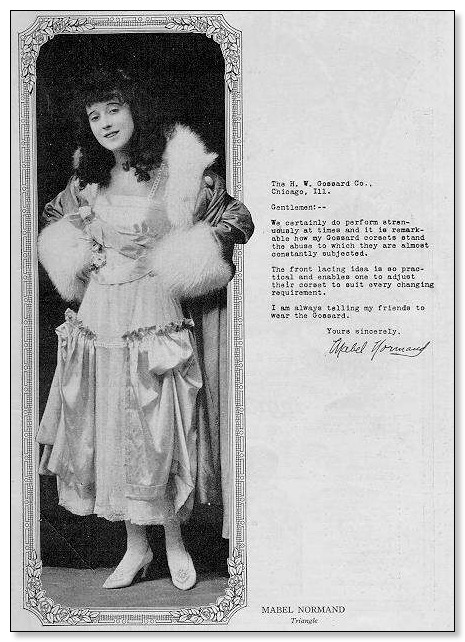
This advertisement originally appeared in September of 1916. (Mabel ad courtesy of Bruce Long.)
This advertisement originally appeared in September of 1916. (Mabel ad courtesy of Bruce Long.)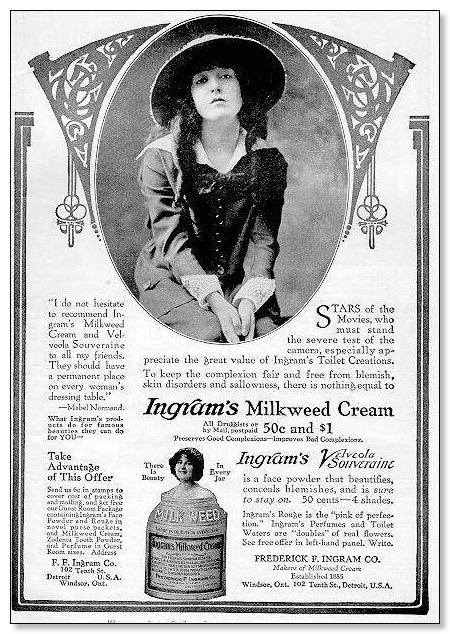
This advertisement originally appeared in October of 1916. (Mabel ad courtesy of Bruce Long.)
This advertisement originally appeared in August of 1918. (Mabel ad courtesy of Bruce Long.)
This advertisement originally appeared in June of 1919. (Mabel ad courtesy of Bruce Long.)
This advertisement originally appeared in July of 1919. (Mabel ad courtesy of Bruce Long.)
This advertisement originally appeared in October of 1919. (Mabel ad courtesy of Bruce Long.)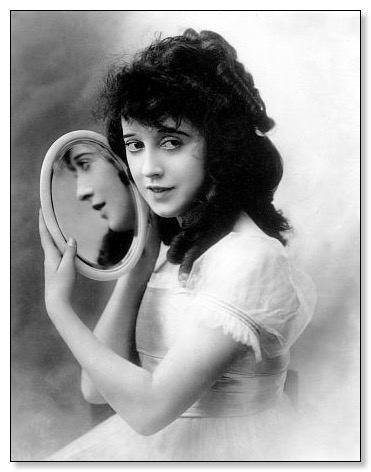
1918 publicity photo, Courtesy MPTV.net
This is actress Mabel Normand with Lee Dougherty, Jr. on the set of a Biograph film.
She was born on Nov. 16, 1894 and was slightly over 16 when she went to work for the Biograph Studio on East 14th Street in New York City.
Mabel was known as Muriel Fortescue in the early days of her acting career. She left Biograph for a short time to work for Vitagraph, but returned in the winter of 1911. Her star continued to rise at Biograph where she became an important star for the studio, working mostly under the direction of Mack Sennett.
Mabel left Biograph with Sennett when he formed Keystone in 1912. He was deeply in love with Mabel and described her "as beautiful as a spring morning." Wedding plans were made several times, but a marriage between the two was never to be.
Starring in several Chaplin films for Sennett, Mabel proved to be the most talented comedienne of the silent era. As her popularity rose, she began to press for more complex roles.
Sennett and his backers, Bauman and Kessel, formed the Mabel Normand Feature Film Company and produced Mickey. The film was not released until 1918 and in the meantime, the disappointed Mabel had signed a five-year contract with Goldwyn.
Without Sennett's guidance, Mabel became part of the social whirl of Hollywood. All-night parties and rumors of drug use began circulating as Mabel began showing up late for work - or disappearing for days at a time.
Mabel's career was dealt a crushing blow in 1922 with the mysterious death of director William Desmond Taylor. She was linked romantically with Taylor and was dragged into the case because she was the last person to see him alive. She was proved innocent, but the ghastly press coverage permanently ruined her image as a star.
Just as she was recovering from the Taylor scandal, her chauffeur was found, gun in hand, standing over the body of millionaire, Cortland Dines. Reportedly, the gun belonged to Mabel. Her popularity rapidly began a downward spiral. Her last feature was The Extra Girl in 1923.
She married Lew Cody, the villain in Mickey. Her happiness was doomed from the beginning as both she and Cody were suffering from terminal illnesses. Cody had a fatal heart condition and Mabel succumbed to tuberculosis and pneumonia. She died in 1930.
In 1974, she was portrayed in the Broadway musical, "Mack and Mabel" by Bernadette Peters.
Destin tragique que celui de Mabel Normand.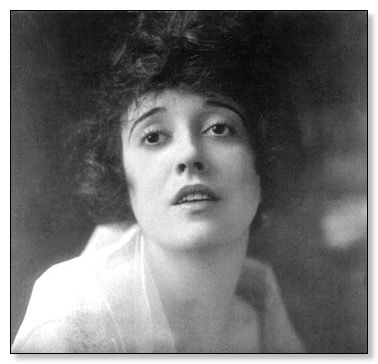
Née en 1892 à Staten Island (New York), Mabel Normand était d'une grande beauté ; elle savait également jouer la comédie, possédait un sens de l'humour merveilleux et, plutôt acrobatique, elle avait cette facilité de pouvoir recevoir autant de coups qu'elle pouvait en donner au cours de tournages souvent improvisés.
D'abord chez Vitagraph (de 1910 à 1912), elle fut dirigée quelque temps par D. W. Griffith puis suivit Mack Sennett à Hollywood.
De 1912 à 1916, elle tourna plus de 125 films pour la compagnie de Sennett, souvent ayant dans leur titre son propre nom : Mabel’s Bear Escape, Mabel Lost and Won, etc.
En 1915, elle était devenue la comédienne la plus connue dans l'industrie du cinéma mais comparativement à Mary Pickford ou Charles Chaplin, son salaire était une maigre pitance.
Quittant Sennett, elle passa chez Samuel Goldwyn, revint chez Sennett pour finalement obtenir le contrat qu'elle désirait auprès de Hal Roach.
De toutes les fêtes, menant une vie mouvementée, elle fut malheureusement mêlée aux deux grands scandales hollywoodiens des années vingt (Fatty Arbuckle, son compagnon dans de nombreux film, accusé de meurtre, et l'assassinat de William Desmond Taylor). Le tollé de protestations des ligues moralisantes qui suivit ces deux affaires détruisit sa popularité comme celles de plusieurs autres comédiens.
Elle tourna son dernier film en 1927 et mourut, alcoolique et de tuberculose, en 1932.
http://www.udenap.org/groupe_de_pages_08/normand_mabel.htm
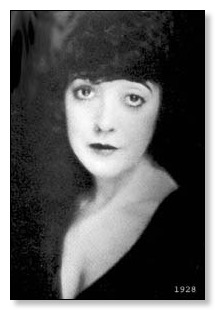
More on : http://fr.wikipedia.org/wiki/Mabel_Normand

